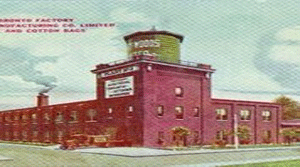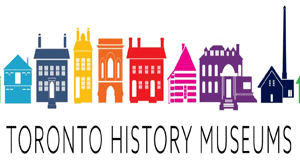Heritage Toronto is pleased to announce the launch of the Dundas + Carlaw Heritage Plaque District. Comprising 10 plaques and a self-guided tour, the area is the first in Toronto to be comprehensively interpreted by the Plaques and Public Education Program. 5,000 tour brochures will be distributed throughout the district, allowing residents and visitors to learn more about the history of the area and its transformation to an arts and cultural hub.
“Plaques make history truly accessible, on the street, 24 hours a day,” says Allison Bain, Executive Director of Heritage Toronto. “This project tells a larger story. Using a series of

Wrigley Chewing Gum Factory in Dundas-Carlaw heritage area.
plaques and a tour, we can explore the relationships between landscapes, businesses, and people that, over time, have resulted in a unique place – a distinct community.”
With a focus on industrial heritage, Heritage Toronto wanted to hear from the thousands of people who lived, worked, and sometimes played in the Dundas and Carlaw area. The project collected first-hand accounts from the public: from couples who met while working at the Carlaw factories, to entire families who were employed in the neighbourhood.
“It was a very home-like experience. Everybody was concerned for everyone else. Every year at Christmas time, the CEO and president who were from the Jewish faith nevertheless threw a Christmas party that was to die for. They were very good to their employees,” says Yvonne Nearing of her job at Reliable Toy. These lived experiences are featured in the self-guided tour
The Dundas + Carlaw Heritage Plaque District is part of the Dundas Carlaw Public Realm Improvements, a community initiative championed by Councillor Paula Fletcher with the support of City Council.
“Cities around the world are looking to their past to build a brighter future,” says Councillor Fletcher. “When complete with improvements to public outdoor spaces in the area, the district will rival other post-industrial revitalization projects like the Lachine Canal National Historic Site in Montreal”.
All are invited to attend the unveiling of the Heritage Plaque District Sunday, June 17, 2018. The event starts at 1:00 pm with brief remarks at Jimmie Simpson Park (872 Queen Street East), followed by a 90-minute guided tour of the area highlighting the new plaques. A digital tour is being developed and will be available in 2019.
Among the themes addressed by the new Heritage Plaque District are:
MEN & WOMEN – Jobs in the Dundas and Carlaw factories were strongly divided according to gender. Men tended to work on the production line or in management while women were generally in packaging or clerical roles. Some companies employed single women. Married women were expected to work in the home. Others, like the Reliable Toy Co., would only hire married women if their spouses worked elsewhere.
CITY BUILDING – To accommodate the growing automobile traffic after the Second World War, the city built expressways, widened existing streets, and in the east end, extended Dundas Street East from Broadview Avenue to Kingston Road. Between Logan and Carlaw Avenues no road existed, so one was created. To accommodate the new street, the Woods Manufacturing complex was split in half. The Canada Starch warehouse was permanently cut off from the complex and left marooned on the south side of the street.
WAR & INGENUITY – Many factories in the Dundas and Carlaw area made changes to production during the Second World War. The Reliable Toy Co. made plastic bullet tips and oil cans for the military while Wrigley, faced with dwindling supplies of gum, completely stopped selling its Spearmint, Doublemint, and Juicy Fruit products at home and sent them to soldiers instead. This shrewd move helped create brand loyalty. After the war, Reliable Toy used its plastics expertise to make some of the first plastic toys in Canada—some of them from wartime surplus.
— Lucy Di Pietro
 TheBulletin.ca Journal of Downtown Toronto
TheBulletin.ca Journal of Downtown Toronto
